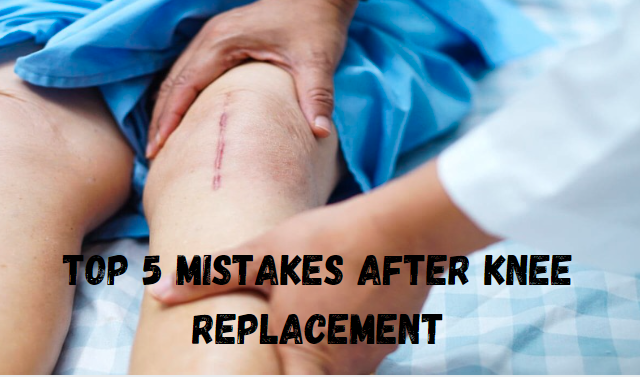Knee replacement surgery, also known as knee arthroplasty, is a common procedure performed to alleviate pain and restore function in severely diseased knee joints. While the surgery itself is crucial, the recovery process plays an equally important role in ensuring a successful outcome.
Unfortunately, many patients make mistakes during their recovery that can hinder their progress. This comprehensive guide will delve into the top 5 mistakes after knee replacement surgery, providing in-depth insights, analyses, and strategies to avoid these pitfalls.
Contents
- 1 1. Doing Too Much Too Soon
- 2 2. Skipping Physical Therapy
- 3 3. Neglecting Physical Therapy
- 4 4. Overexertion
- 5 5. Driving After a Knee Replacement
- 6 FAQs
- 6.1 1. How long should I wait before driving after knee replacement surgery?
- 6.2 2. What types of exercises are safe during knee replacement recovery?
- 6.3 3. Can I resume sports activities after knee replacement surgery?
- 6.4 4. How can I manage pain during knee replacement recovery?
- 6.5 5. What should I do if I experience increased pain or swelling during recovery?
- 7 Conclusion
1. Doing Too Much Too Soon
One of the most common mistakes after knee replacement surgery is doing too much too soon. Patients often feel a sense of euphoria after their pain diminishes and mobility improves, leading them to overestimate their physical capabilities. However, pushing the knee too hard can lead to complications such as swelling, increased pain, and even damage to the new joint.
Understanding the Risks
Overexertion can cause inflammation around the knee, which can be counterproductive to the healing process. This inflammation can lead to increased pain and stiffness, making it more difficult to achieve the desired range of motion. Additionally, overuse of the knee can result in more severe complications, such as joint instability or damage to the prosthetic components.
Best Practices
To avoid doing too much too soon, patients should adhere to the following guidelines:
- Follow the Surgeon’s Instructions: Your surgeon will provide a detailed recovery plan. Adhere strictly to their recommendations regarding activity levels.
- Gradual Progression: Increase physical activity gradually. Start with gentle exercises and slowly build up intensity and duration.
- Listen to Your Body: Pay attention to signs of overexertion, such as increased pain, swelling, or fatigue. If you experience these symptoms, reduce your activity levels and consult your healthcare provider.
2. Skipping Physical Therapy
Skipping physical therapy is another significant mistake that can impede recovery. Physical therapy is essential for restoring strength, flexibility, and range of motion in the knee joint. It also helps prevent complications such as scar tissue formation and joint stiffness.
The Importance of Physical Therapy
Physical therapy plays a critical role in the recovery process by:
- Improving Mobility: Therapeutic exercises help increase the range of motion in the knee joint.
- Strengthening Muscles: Strengthening the muscles around the knee provides better support and stability.
- Reducing Pain: Proper exercises can help alleviate pain and reduce swelling.
Commitment to Rehabilitation
To maximize the benefits of physical therapy:
- Attend All Sessions: Consistently attend all scheduled physical therapy sessions.
- Perform Home Exercises: Follow the prescribed home exercise program diligently.
- Communicate with Your Therapist: Keep your physical therapist informed about any pain or difficulties you encounter during exercises. They can adjust your program accordingly.
3. Neglecting Physical Therapy
Neglecting physical therapy, even partially, can lead to suboptimal outcomes. Patients might attend sessions but fail to perform their home exercises regularly, undermining their progress.
Consequences of Neglect
Neglecting physical therapy can result in:
- Limited Range of Motion: Without regular exercises, scar tissue can form, restricting movement.
- Weak Muscles: Lack of consistent exercise can weaken the muscles around the knee, leading to instability.
- Increased Pain: Neglecting therapy can cause persistent pain and discomfort.
Ensuring Consistency
To avoid neglecting physical therapy:
- Set a Routine: Incorporate your home exercises into your daily routine at a consistent time.
- Track Progress: Keep a log of your exercises and improvements to stay motivated.
- Seek Support: Engage family or friends to support and encourage you in your recovery journey.
4. Overexertion
Overexertion is a critical mistake that overlaps with doing too much too soon but deserves its own focus due to its prevalence and the severe consequences it can entail.
Understanding Overexertion
Overexertion refers to pushing the knee beyond its limits, either through high-impact activities or excessive repetitive movements. This can happen when patients are eager to return to their normal routines or participate in sports too early.
Risks of Overexertion
The risks associated with overexertion include:
- Prosthetic Loosening: Excessive stress on the knee can cause the prosthetic components to loosen.
- Increased Pain and Swelling: Overuse can lead to chronic inflammation, pain, and swelling.
- Joint Damage: High-impact activities can cause wear and tear on the new joint.
Preventing Overexertion
To prevent overexertion:
- Avoid High-Impact Activities: Refrain from activities that put excessive strain on the knee, such as running or jumping.
- Moderate Exercise: Engage in low-impact exercises such as walking, swimming, or cycling.
- Rest and Recovery: Ensure adequate rest periods between exercise sessions to allow the knee to heal and recover.
5. Driving After a Knee Replacement
Driving too soon after knee replacement surgery is a common mistake that can pose significant risks to the patient and others on the road. It is crucial to wait until you have regained sufficient strength, mobility, and reaction time before getting behind the wheel.
Risks of Early Driving
Driving prematurely can result in:
- Delayed Reaction Time: Reduced strength and mobility can impair your ability to react quickly in emergency situations.
- Increased Pain: Operating the pedals can strain the knee, leading to increased pain and discomfort.
- Accidents: Limited control over the vehicle can increase the risk of accidents.
Guidelines for Safe Driving
To ensure safe driving post-surgery:
- Follow Medical Advice: Wait until your surgeon gives you the green light to drive.
- Test Your Abilities: Practice in a safe, controlled environment to ensure you have adequate control over the vehicle.
- Avoid Long Drives: Start with short trips and gradually increase the duration as you become more comfortable.
FAQs
1. How long should I wait before driving after knee replacement surgery?
The typical waiting period before driving is around 4-6 weeks, but this can vary based on individual recovery rates and your surgeon’s advice. Always follow your surgeon’s specific recommendations.
2. What types of exercises are safe during knee replacement recovery?
Low-impact exercises such as walking, swimming, cycling, and specific physical therapy exercises are safe and beneficial during knee replacement recovery. Avoid high-impact activities like running or jumping.
3. Can I resume sports activities after knee replacement surgery?
You can resume certain low-impact sports activities, but it is crucial to consult with your surgeon and physical therapist before doing so. Activities like golf, swimming, and cycling are generally safe, while high-impact sports should be avoided.
4. How can I manage pain during knee replacement recovery?
Pain management can include prescribed medications, physical therapy, ice therapy, and gentle exercises. Always consult your healthcare provider for a personalized pain management plan.
5. What should I do if I experience increased pain or swelling during recovery?
If you experience increased pain or swelling, reduce your activity levels and consult your healthcare provider. It may indicate overexertion or other complications that need medical attention.
Conclusion
Avoiding the top 5 mistakes after knee replacement surgery—doing too much too soon, skipping physical therapy, neglecting physical therapy, overexertion, and driving too early—can significantly enhance your recovery process and outcomes.
By following a structured recovery plan, adhering to medical advice, and staying committed to physical therapy, you can achieve a successful and smooth recovery. Always remember to listen to your body, communicate with your healthcare providers, and prioritize your long-term health over short-term gains.




